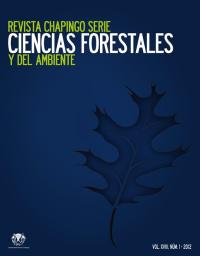Resumen
Las masas forestales enfrentan el problema de productividad, la cual demanda que se incremente en cantidad y calidad. El crecimiento forestal depende de varios factores, entre ellos, el edáfico, que actúa sobre el árbol mediante el agua y los elementos minerales. Se incrementa la productividad fo¬restal al mejorar la disponibilidad nutrimental mediante la fertilización. Consecuentemente, la finalidad de este trabajo fue estudiar la fertilización con nitrógeno (0, 138,185), fósforo (0, 15, 21) y potasio (0, 123,164) kg•ha-1 con relación al crecimiento de follaje nuevo, mediante un experimento factorial 33 en una plantación de Pinus patula Schl. et Cham. de 10 años de edad, en Aquixtla, Puebla, durante 2009-2010. La tasa relativa de crecimiento instantáneo (TCRI) en volumen de follaje nuevo fue mejor (0.0255 mL•mL-1•día-1) con la dosis 185-0-0 kg•ha-1 de NPK, y la TCRI de peso seco fue mejor (0.0254 y 0.0249 g•g-1•día-1, respectivamente) con las dosis 138-0-123 y 138-0-0. Se determinó deficiencia de nitrógeno, que se atribuyó a la acidez edáfica y a la lenta mineralización de la materia orgánica. La dosis recomendada para las condiciones edáficas y climáticas del sitio experimental fue 185-0-0 kg•ha-1 NPK para volumen de follaje nuevo y 138-0-0 kg•ha-1 de NPK para peso seco.
Citas
Black, C. A. (1975). Relaciones Suelo-Planta. Argentina: Hemisferio Sur.
Crous, J. W., Morris, A. R., & Scholes, M. C. (2009). Effect of phosphorus and potassium fertilizer on tree growth and dry timber production of Pinus patula on gabbro-derived soils in Swaziland. Southern Forests: a Journal of Forest Science, 71(3), 235-243 doi: https://doi.org/10.2989/SF.2009.71.3.8.920
Dovey, S. B. (2009). Estimating biomass and macronutrient content of some commercially important plantation species in South Africa. Australian Forestry, 72(2), 99-111.
Fisher, R. & Binkley, D. (2000). Ecology and Management of Forest soils (3a ed.). USA: John Wiley & Sons.
Fox, T. R., Allen, H. L., Albaugh, T. J., Rubilar, R. & Carlson, C. A. (2007). Tree nutrition and forest fertilization of pine plantations in the southern United States. Southern Journal of Applied Forestry, 31(1), 5-11.
Hewitt, E. J. & Smith, T. A. (1975). Plant mineral nutrition. London: The University Press.
Hunt, R. (1981). Plant growth analysis. London: Edward Arnold. http://aob.oxfordjournals.org/content/48/3/341.abstract
Huber, Don M. & Thompson I. A. (2007). Nitrogen and plant disease. In: L.E., Datnoff, W.H., Elmer, and Don M., Huber, (Eds.), Mineral Nutrition and Plant Disease (pp. 31-44). USA: The American Phytopathological Society Press.
Kramer, J. P. & Kozlowski, T. (1979). Physiology of Wood Plants. New York: Academic Press. http://es.scribd.com/doc/5015386/Physiology-of-woody-plants
Mayor, X., Belmonte, H., Rodrigo, A., Rodá, F. & Piñol, J. (1994). Crecimiento diametral de la encina (Quercus ilex L.) en un año de abundante precipitación estival: efecto de la irrigación previa y de la fertilización. Orsis, 9, 13-23. http://ddd.uab.cat/pub/orsis/02134039v9p13.pdf
Mengel, K. & Kirkby, E. A. (1982). Principles of plant nutrition. Switzerland: International Potash Institute. http://books.google.com.mx/books?id=UEGW-7C-bxYC&printsec=frontcover&hl=es&source=gbs_ge_summary_r&cad=0#v=onepage&q&f=false
Morris, A. R. (2003). Site and stand age effects on fertilizer responses in Pinus patula pulpwood plantations in Swaziland. Southern African. Journal Forestry, 199, 27-39. http://www.sabinet.co.za/abstracts/forest/forest_n199_a4.html
Oliét, J., Robredo, E., Salazar, J. M. & Villar, R. (2008). Fertilización otoñal de encina en vivero: efectos sobre la morfología, nutrientes, potencial de enraizamiento y respuesta postrasplante. Sociedad Española de Ciencias Forestales, 28, 171-176.
Ortiz-Villanueva, B. (1973). Edafología. México. Patena.
Porta, J., López-Acevedo, M. & Roquero, C. (2003). Edafología para la agricultura y el medio ambiente (3a ed.). España: Mundi Prensa
Puértolas, J., Gil, L. & Pardos, J. A. (2003). Effects of nutritional status and seedling size on field performance of Pinus halepensis planted on former arable land in the Mediterranean basin. Forestry, 76(2), 159-168. doi: https://doi.org/10.1093/forestry/76.2.159
Pritchett, W. (1991). Suelos forestales. Propiedades, conservación y mejoramiento. México: Limusa
Rikala, R. & Repo, T. (1997). The effect of late summer fertilization on the frost hardening of second-year Scots pine seedlings. New Forests, 14, 33–44. doi: https://doi.org/10.1023/A:1006505919556
Tippens, P. (2001). Física: conceptos y aplicaciones (4a ed.). México: McGraw-Hill Interamericana.
Turner, J., Mambert, M. J. & Humphreys, F. R. (2002). Continuing growth response to phosphate fertilizers by a Pinus radiate plantation over fifty years. Forest Science a Quartely Journal of Research Technical Progress, 48(3), 556-568.
Villar-Salvador, P., Planelles, R., Enríquez, E. & Peñuelas, J. L. (2004). Nursery cultivation regimes, plant functional attributes, and field performance relationships in the Mediterranean oak Quercus ilex L. Forest Ecolgy Manegement, 196, 257-266. doi: https://doi.org/10.1016/j.foreco.2004.02.061

Esta obra está bajo una licencia internacional Creative Commons Atribución-NoComercial 4.0.
Derechos de autor 2012 Revista Chapingo Serie Ciencias Forestales y del Ambiente



